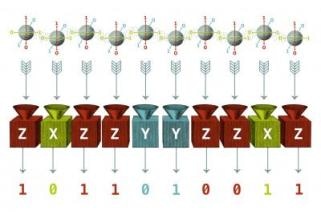Feb 19 2018
The decisive aim of quantum information science is to create a quantum computer, a completely developed controllable device which exploits the quantum states of subatomic particles for the storage of information.
Similar to other quantum technologies, quantum computing is dependent on quantum entanglement, a distinctive characteristic of quantum mechanics. If the quantum computer should be in a position to accomplish its full capability, qubits, or the fundamental units of quantum information, have to correlate in this specific way.
 Entangled qubits are sent to measurement devices which output a sequence of zeroes and ones. This pattern heavily depends on the type of measurements performed on individual qubits. If we pick the set of measurements in a peculiar way, entanglement will leave unique fingerprints on the measurement patterns. (Image credit: Juan Palomino)
Entangled qubits are sent to measurement devices which output a sequence of zeroes and ones. This pattern heavily depends on the type of measurements performed on individual qubits. If we pick the set of measurements in a peculiar way, entanglement will leave unique fingerprints on the measurement patterns. (Image credit: Juan Palomino)
A major difficulty is to ensure that a completely operational quantum computer works as expected. Specifically, researchers have to demonstrate that a large number of qubits are entangled in a reliable manner. Traditional techniques mandate a large number of repeated evaluations of the qubits for dependable corroboration. The higher the number of repeated evaluations, the more definite is the presence of entanglement. Hence to achieve standardization of the entanglement in huge quantum systems, more time and resources are needed, which is challenging or just improbable. Therefore, the main question is as follows: Can entanglement be corroborated with just a few evaluation trials?
At present, scientists from the University of Belgrade, the University of Vienna, and the Austrian Academy of Sciences have devised an innovative verification technique requiring considerably lesser resources and, in various instances, just a single evaluation run to corroborate large-scale entanglement with higher assurance.
According to Aleksandra Dimić from the University of Belgrade, the optimal way to gain an in-depth knowledge of this phenomenon is to adopt the following analogy: “Let us consider a machine which simultaneously tosses, say, ten coins. We manufactured the machine such that it should produce correlated coins. We now want to validate whether the machine produces the anticipated result. Imagine a single trial revealing all coins landing on tails. This is a clear signature of correlations, as ten independent coins have 0.01% chance to land on the same side simultaneously. From such an event, we certify the presence of correlations with more than 99.9% confidence. This situation is very similar to quantum correlations captured by entanglement.”
According to Borivoje Dakić, “In contrast to classical coins, qubits can be measured in many, many different ways. The measurement result is still a sequence of zeros and ones, but its structure heavily depends on how we choose to measure individual qubits.” He concluded by saying, “We realized that, if we pick these measurements in a peculiar way, entanglement will leave unique fingerprints in the measured pattern.”
The innovative technique devised by the researchers assures a drastic reduction in resources and time required for reliable standardization of futuristic quantum devices.